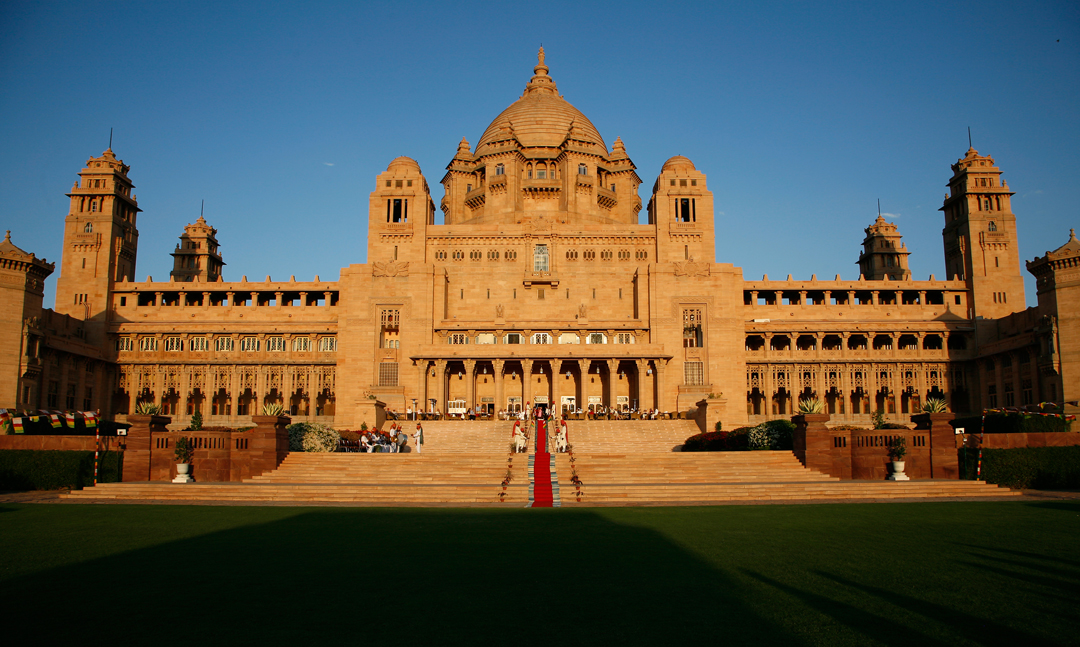


Umaid Bhawan Palace at sunset
A dramatic transformation in Jodhpur is triggered by India’s encounters with the British Empire in the 19th century. By 1876, Queen Victoria took the title of Empress of India and set off a new wave of European aesthetics. Merging with traditional Indian garments, paintings, and jewelry, an imperial hierarchy was emphasized during the era of British rule known as the Raj. During the 20th century, the maharajas of Jodhpur became renowned for innovative patronage. In 1944, Umaid Bhawan Palace was completed and is now operated as a hotel by the Taj group. Today, this legacy continues with the current leader of Marwar-Jodhpur, His Highness Maharaja Gaj Singh II.
Images: Western Ramparts of the Mehrangarh Fort, Jodhpur, photo: Neil Greentree. The Goddess Fights the Buffalo Demon, Folio 20 from the Durga Charit (detail), ca. 1780-90, Jodhpur, opaque watercolor and gold on paper, 50 × 18 7/8 in., Mehrangarh Museum Trust, photo: Neil Greentree. Band member on the steps of Umaid Bhawan during a celebration, photo: Neil Greentree. Doorway in the blue city, photo: Neil Greentree. Shiva and Parvati in Conversation; Shiva on His Vimana (Aircraft) with Himalaya, Folio 53 from the Shiva Rahasya, 1827, Jodhpur, opaque watercolor and gold on paper, 16 1/2 × 45 5/8 in., Mehrangarh Museum Trust, photo: Neil Greentree. Mehrangarh Fort high on an outcrop of red sandstone showing Jaswant Thada in the foreground and the blue city of Jodhpur (detail), photo: Neil Greentree. Royal Procession recreated at Mehrangarh Fort, Jodhpur, photo: Neil Greentree. The Mahi-o-maratib (Fish Insignia) in Procession, ca. 1715, Jodhpur, opaque watercolor and gold on paper, 11 1/4 × 8 1/8 in., Mehrangarh Museum Trust, photo: Neil Greentree. Cover for a Lady’s Palanquin, late 19th century or early 20th century, Varanasi, silk brocade, 39 x 77 3/16 x 39 3/4 in., Mehrangarh Museum Trust, photo: Neil Greentree. Installation view of Peacock in the Desert: The Royal Arts of Jodhpur, India at the Museum of Fine Arts, Houston, photo: Will Michels. Howdah with Chattr (Elephant Seat with Parasol), early 19th century, Jodhpur, wood, silver, velvet, silver gilt thread embroidery, gilded metal finials and cotton frills, enamel, silk brocade, 59 x 36 5/8 x 46 1/2 in., Mehrangarh Museum Trust, photo: Neil Greentree. Mehrangarh Fort, Jodhpur, photo: Neil Greentree. Mahadol (Palanquin), ca. 1700–30, Gujarat, gilded wood, glass, copper and ferrous alloy, 100 3/8 × 143 3/4 × 57 1/8in., Mehrangarh Museum Trust, photo: Neil Greentree. Krishna Jhula (Cradle for Krishna), late 19th century, Rajasthan, gilded wood, glass, paint, lacquer, 111 7/8 x 68 1/8 x 32 3/8 in., Mehrangarh Museum Trust, photo: Neil Greentree. Portrait of Maharaja Ajit Singh, ca. 1830, Amardas Bhatti, Jodhpur, opaque watercolor and gold on paper, 16 7/8 × 13 1/8 in., Mehrangarh Museum Trust, photo: Neil Greentree. The Lal Dera, late 17th to early 18th century, Mughal, silk velvet, silver gilt thread, cotton backing, Mehrangarh Museum Trust. Maharaja Abhai Singh on Horseback, ca. 1725, Dalchand, Jodhpur, opaque watercolor and gold on paper, 14 1/8 × 19 5/8 in., Mehrangarh Museum Trust, photo: Neil Greentree. Khanjar (Dagger), late 17th or early 18th century, Rajput, watered steel, ivory (Indian elephant), 14 1/4 x 1 1/4 in., Mehrangarh Museum Trust, photo: Neil Greentree. Huqqa (Water Pipe) Base, early 18th century, Mughal, glass, gold paint, 7 7/8 × 3 1/8 in., Umaid Bhawan Palace, photo: Neil Greentree. Women of the Zenana Watch a Dance Performance with Bakhat Singh, ca. 1736, Nagaur, opaque watercolor and gold on paper, 17 3/4 × 25 in., Mehrangarh Museum Trust, photo: Neil Greentree. Baradari (Pavilion), 19th century, Jodhpur, wood, paint, lacquer, gold, 120 × 120 in., Mehrangarh Museum Trust, photo: Neil Greentree. A Durbar in the Zenana, ca. 1850, Bulaki, Jodhpur, opaque watercolor and gold on paper, 21 5/8 x 30 3/8 in., Mehrangarh Museum Trust, photo: Neil Greentree. Choker Necklace, 18th or 19th century, India, probably Deccan (Hyderabad), gold worked with kundan technique and set with diamonds; with champeleve enamels; strung with pearls and with pendant emerald beads and pearls, 3 1/8 × 11in., the al-Sabah Collection, Dar al-Athar al Islamiyyah, Kuwait. Jhula (Swing), late 19th century, Rajasthan, soapstone, copper, iron, 67 7/8 x 30 3/4 x 22 in., Mehrangarh Museum Trust, photo: Neil Greentree. The Court of Maharaja Man Singh, ca. 1830, Dana Bhatti, Jodhpur, opaque watercolor and gold on paper, 22 × 29 1/8 in., Mehrangarh Museum Trust, photo: Neil Greentree. Singhasan with Chattr (Throne with Parasol), mid-19th century, Jodhpur, wood, gold, lacquer, velvet, silver gilt, Mehrangarh Museum Trust, photo: Neil Greentree. Maharaja Gaj Singh I Holding Court, ca. 1800, Jodhpur, opaque watercolor and gold on paper, 20 1/4 x 15 in., Mehrangarh Museum Trust, photo: Neil Greentree. Maharao Umed Singh of Kota on a Hunt, 1780, Sheikh Taju, Kota, opaque watercolor and gold on paper, 20 1/2 x 26 in., Mehrangarh Museum Trust, photo: Neil Greentree. Umaid Bhawan Palace at sunset, photo: Neil Greentree. Portrait of Maharaja Jaswant Singh II, 1895, Bert Harris, Jodhpur, oil on canvas, 59 7/8 × 48 3/8 in., Umaid Bhawan Palace, photo: Neil Greentree. Design for Her Highness’s Bathroom at Umaid Bhawan Palace, 1944, Stefan Norblin, watercolor on paper, 21 5/8 x 19 1/4 in., Umaid Bhawan Palace, photo: Neil Greentree. Sarpech (Turban Ornament), probably second half of 17th century, India, probably Deccan, gold with champeleve and overpainted enamels; worked in kundan technique and set with diamonds and emeralds, 6 13/16 × 2 1/16 × 1/2 in., the al-Sabah Collection, Dar al-Athar al Islamiyyah, Kuwait. Portrait of Maharaja Sardar Singh, 1896, Bert Harris, oil on canvas, Umaid Bhawan Palace, photo: Neil Greentree. Sculpture of a Peacock, early 20th century, marble, Jodhpur, 34 1/4 x 30 3/8 x 15 in., Umaid Bhawan Palace, photo: Neil Greentree. Typeface: Bluu Next by Jean-Baptiste Morizot, Velvetyne Type Foundry.